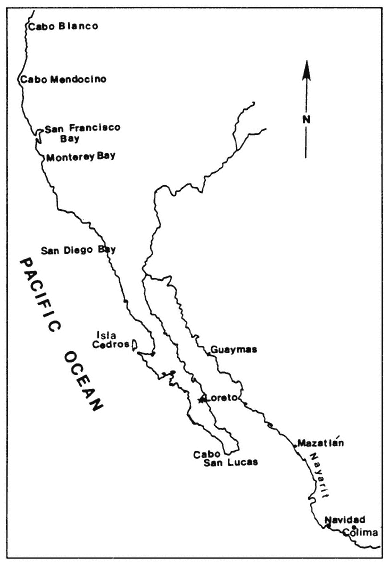The Manila Galleon
The route of the Manila galleon[8] was paramount not only in the further exploration of the California coast from Cabo San Lucas to the northern California region but in the establishment of permanent sea-lanes between the north and south. Once established, these sea routes helped maintain communication between Baja California, Alta California, and the mainland. These sealanes remained permanent migration routes between Baja and Alta California to the present. At the turn of the twentieth century families in the extreme south used these same passages as primary migratory routes between San Diego and Baja California.
The California coast became an immediate concern of the Spanish Crown because of the need for coastal refuges for the Manila galleon on its long voyages. The winds and ocean currents of the Pacific produced natural sea-lanes (the California current) that brought the galleons to the cape, and Cabo San Lucas became a natural resting spot where the ships could readily put in for water and repairs. But additional ports were needed elsewhere along the coast, and new explorations centered around their discovery.
The ensuing years saw several exploratory voyages to the northwest to seek a passage for the Philippine galleons. These included the voyage of Sebastian Rodriguez de Cermeño, who sailed first to the Philippines from Acapulco. Almost simultaneously with Cermeño's return, the viceroy commissioned Sebastian Vizcaíno to explore the Gulf of California and to establish settlements on the peninsula (Bolton 1908:44). On two successive voyages in 1599 Vizcaíno explored the
inner gulf coast from La Paz and later Magdalena Bay, Cedros Island, San Diego Bay (which received its name on this voyage), Santa Catalina, and Monterey Bay (Bolton 1908:46–48). But the search for a port on the Pacific coast ended with the voyage of Vizcaíno. He had explored and mapped the Pacific coast thoroughly but had failed to secure a port for the galleon.
Until the late sixteenth century the exploration of the Pacific coast had kept pace with the general Spanish penetration of the continent, but continuing failure to secure good settlements and harbors along the coast and the growing recognition that the peninsula was a marginally productive region combined to shift attention away from the coast and peninsula. The seventeenth century witnessed surging development on the mainland while Baja California stagnated. This peripheral nature of Baja California within the New Spanish system was furthermore compounded by the threat posed by the English buccaneers, Drake, Cavendish, and later Woodes Rogers and George Shelvoke (Englehardt 1929:29–31), who all roamed the open seas plundering Spanish vessels. In addition, Dutch freebooters had established themselves at Pichilingue outside of La Paz and were a constant menace to mainlanders (Engelhardt 1929:80).
The Spanish population of the mainland had settled in the sixteenth century and by 1550 had begun to branch northward to open new lands and eventually new economic bases for the Spanish. Mexico itself was becoming more and more independent of Spain. The clergy, who had entered Mexico during the conquest, made the northern expansion successful. The church made a great investment in evangelization on the mainland, but this interest was not to be seen in Baja California until the next century.
In brief, Baja California provided no riches, no great cities, and no great populations to evangelize. Furthermore, colonists saw Baja as a barren wasteland in which the European could not live. All the settlements attempted between 1533 and 1680 had failed. There was no water, and all provisions had to be imported across a sea plagued by dangerous currents and winds. The only predictability in Baja California was the lack of rain. Expeditions up the Pacific coast in search of suitable harbor and settlement locations brought no immediate benefit to the Spanish. They did place California on the cartographic map of the world and set the stage for communication, future settlement, and mobility in the Californias.

Map 2.
Pacific West Coast of Alta and Baja California